
Weekend in Quebec City | Canada
Quebec is both a city and a province, and I did have to get my mum to clarify a dozen times in conversations which one she was referring to when saying just “Quebec”. From Montreal, we continued the French-Canadian leg of our trip by catching the train along the St Laurence river, to the provincial capital. My biggest takeaway from our weekend in Quebec City was just how French-influenced it is, mainly in the architecture, making it feel very historic. The old city centre was once a walled fortress, making it pretty small and walkable perfect for a weekend trip.

Day One
Up the Hill to Old Quebec
So, fun fact, if you didn’t know. The sensible place to put a walled city, to protect from invasion, is on top of a hill. Logical, makes sense. This fact becomes less fun, however, when you’re staying in an apartment at the bottom of said hill. There are buses, but just based on where the routes go, it was actually quicker for us to walk. We were faced with a hefty staircase no matter which way we went, and slowly hauled our way to the top.
It was a pretty short walk from there to the city walls though, to enter the old town proper. I’d also say it’s much better to walk around the old town than take a car up there, since’s a lot of the roads are narrow or pedestrianised. That definitely adds to the European feel as well though – gosh, do I miss living in a more compact city! – as well as the architecture we were immediately surrounded by. Continuing the French theme, we stopped to have crepes for breakfast!
Rue du Tresor & Place d’Armes
We wound our way past the shops towards the Place d’Armes, near the centre of the old quarter. On the way, we popped into the Notre-Dame basilica, a 17th century church adorned in opulent white and gold. To get from there to the square, we took the Rue du Tresor. This narrow alleyway is crammed with artists’ stalls, selling their paintings mainly of Quebec City. Each has their own style though, so it was fun to browse all the different portrayals of the city.
Emerging in the Place d’Armes, there were some more stalls selling more craft and clothing items that we wandered past too. The square is lined with pavement cafes down one side, typical of France, with greenery and statues in the centre. There were street performers as well, doing their acts in every language – French, English and I heard some Spanish!







Dufferin Terrace & Fairmont Le Chateau Frontenac
One side of the Place d’Armes is entirely occupied by Le Chateau Frontenac, and another is the beginning of Dufferin Terrace. This pedestrian terrace runs along the edge of the hilltop, looking down to the Petit Champlain and St Lawrence River below. The Chateau dominates the scene, a magnificent castle of turrets and towers and hundreds of rooms inside. It looks like it could be centuries old and home to nobility, but it’s actually a Fairmont Hotel that was purpose-built in the late 19th century. It’s very much the centrepiece of the old town though and the most famous building in the city. We went for a look around their lobby and shops too, just to see how fancy it is on the inside!
We then wandered along Dufferin Terrace, admiring the chateau from all angles and passing the Victorian-style gazebos and lampposts along the way. The original plan was to follow the path all the way around the Citadelle to the Plains of Abraham, but halfway around, the path closed. It turned out there was a big music festival on all week, and the stages were at one end of the Plains, so they closed the route off. We doubled back and took a loop through the old quarter, up the pretty Rue Saint-Louis, lined with shops and restaurants. We circled back on the Rue Sainte-Anne, passing the fountains outside City Hall and back to the Place d’Armes.







Petit Champlain
What goes up, must come down. Half of the old town is down the hill again, next to the river. The funicular is a popular option to spare you the walk, but we were saving that until later. Instead, we walked down the curving Côte de la Montagne and exited the walled city through the Prescott Gate. We skipped the Breakneck Stairs – the city’s oldest and some of its steepest – and instead went to see the Quebec City Mural. Covering an entire building’s side, it looks like a street scene and is filled with significant figures from Quebec’s history. Fortunately there’s a sign nearby to explain who all of them are as well!
From there, it’s a quick walk through Place Royale to reach the Rue Petit Champlain. Sometimes this whole area seemed to be referred to as ‘Petit Champlain’ but the street bearing the name is the main one, a narrow, pedestrian alley crammed with unique shops. There’s plenty to see here, and it’s all very pretty and scenic. And again, felt very European in style, down to the buskers performing their music. Don’t miss the nearby Umbrella Alley too!






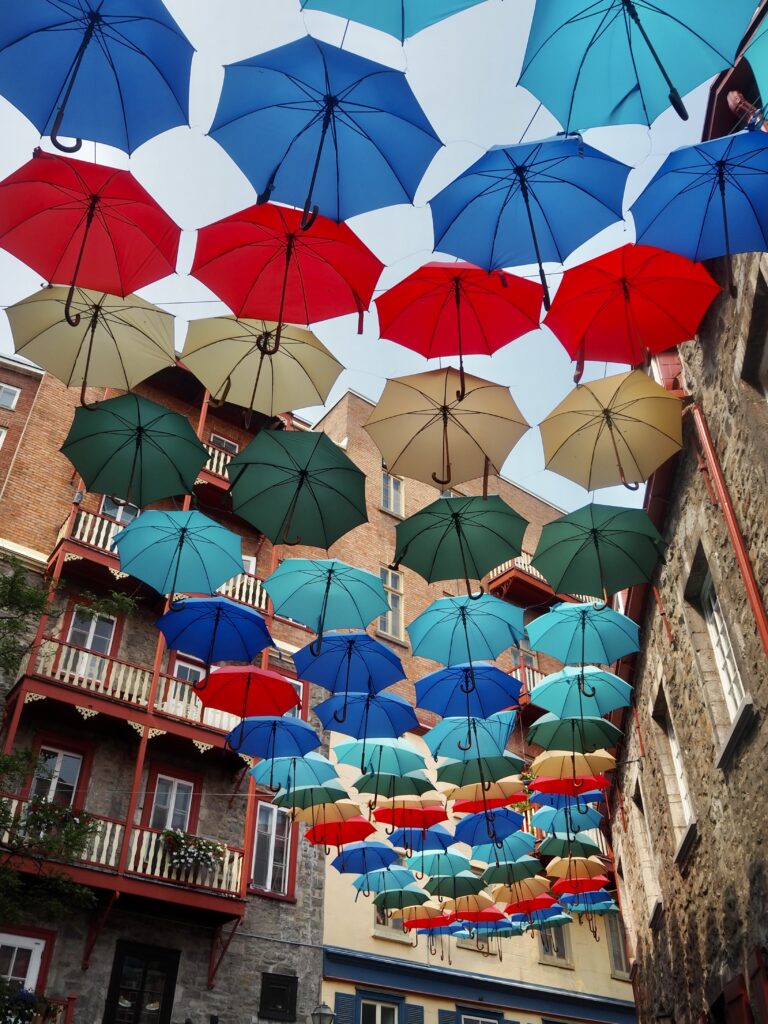
River Cruise
After sufficiently browsing the Petit Champlain shops, we headed to the riverside for our afternoon activity, a cruise up the St Lawrence River with Croisières AML. Luckily, it was a sunny enough day to sit on the open-top deck, where we got some local beer and snacks to enjoy on the ride. The guide was up here too (though his microphone connects through the whole boat) in period costume and telling us all about Quebec’s history and the sights we were seeing.
The cruise sailed towards the Île d’Orléans, a large island in the centre of the river. It has a small population and a lot of farmland with a rather warm climate for growing local produce. We sailed past its southern tip and towards the bridge connectuing it to the mainland. From here, we could spot Montmorency Falls, a towering waterfall on the river’s edge. It was here that the boat spun around and began its return to port, giving us views of Quebec City and the Chateau Frontenac dominating the skyline. The whole cruise took about an hour and a half and was a relaxing way to spend an afternoon.
Funicular & Grand Allée
Back on dry land, we had to get back up the hill and through the old town again. This time, we boarded the funicular, the tiny car that whisks you up its incredibly steep track in just a few minutes. There’s often a long line, especially to go uphill and save yourself the walk! But it moves pretty quickly and they squeeze a lot of people in each car. It only costs a couple of dollars too, so it’s a fun little addition to a sighsteeing weekend in Quebec City.
At the top, we walked the Rue Saint-Louis through the walled city again, exiting on the other side at the St Louis Gate. We then passed through the area where the music festival was taking place, so big crowds were entering the various stage areas. It also meant that the Grand Allée, our destination, was very busy too! Luckily we had made a dinner reservation in advance and squeezed into the terrace of a seafood restaurant. It was jammed and pretty loud with the music filtering over, but the food was good! After, we escaped the crowds and walked back downhill (yet again) to our apartment for the night.
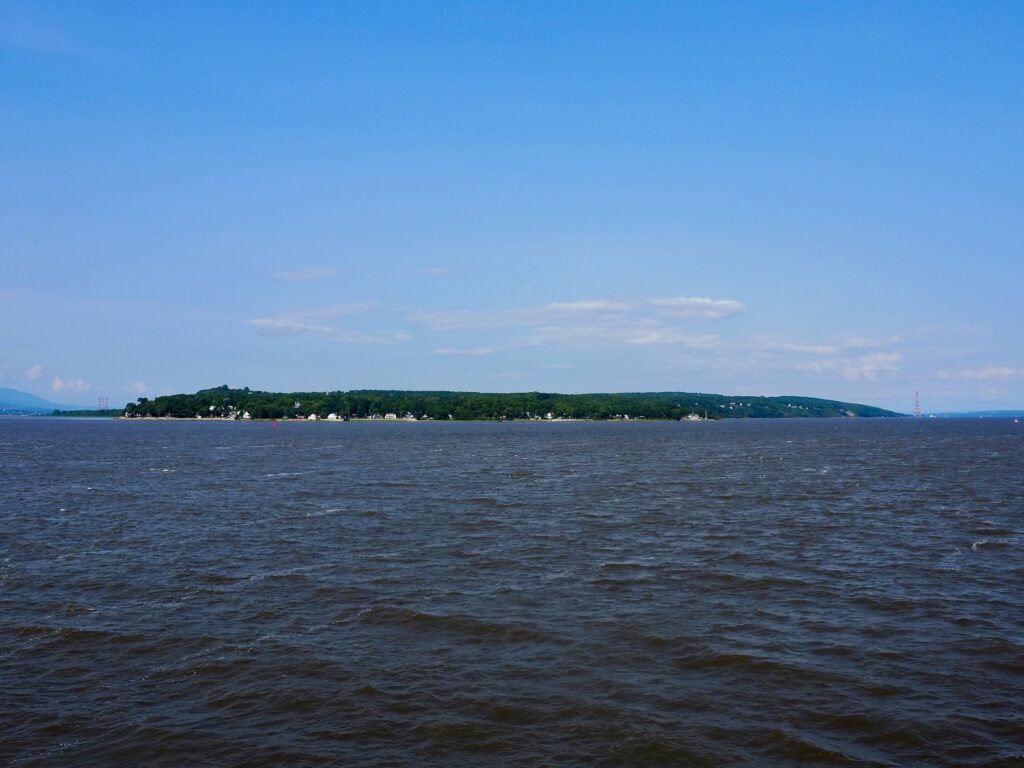


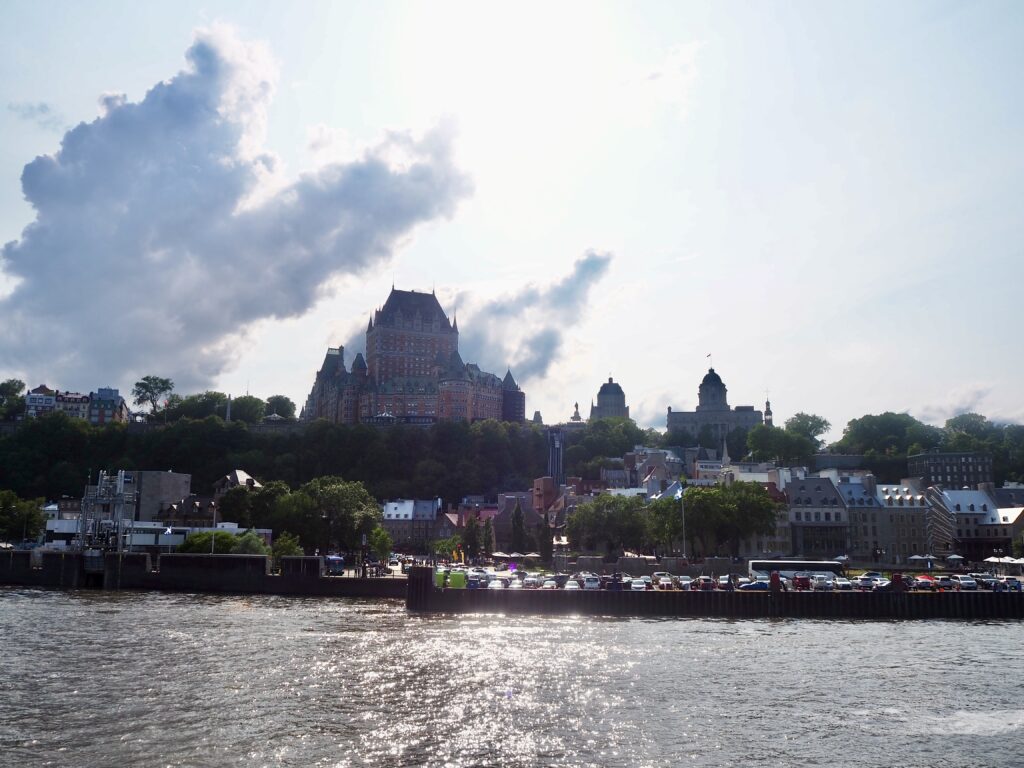
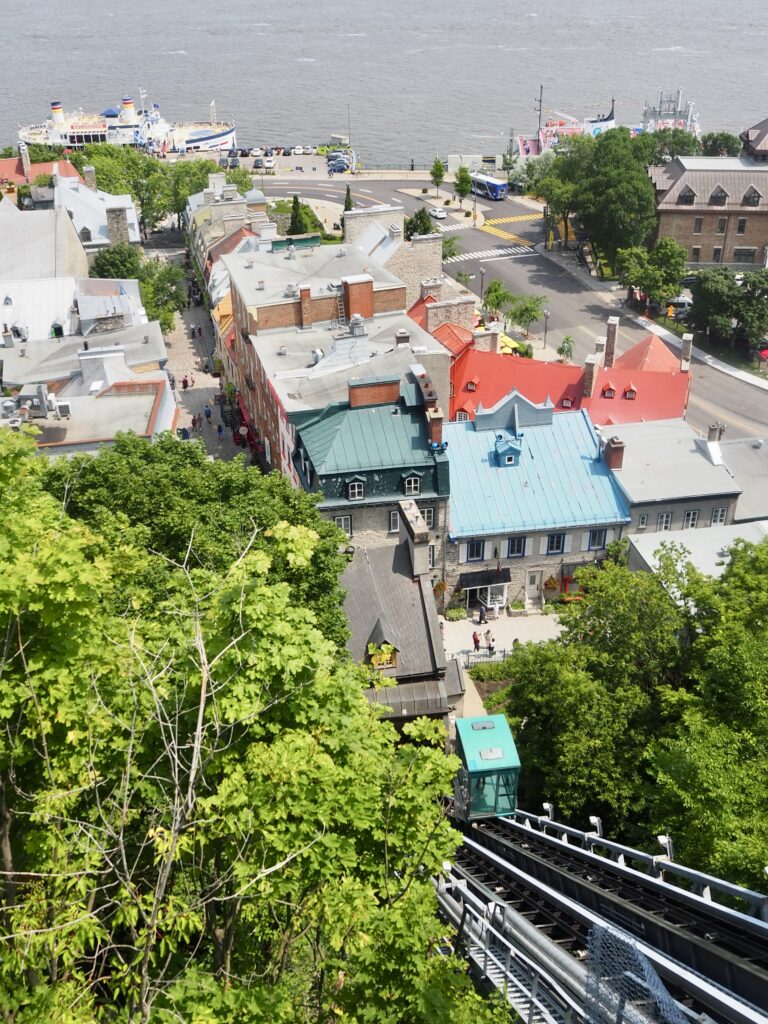


Day Two
Plains of Abraham
The second day of our weekend in Quebec City was significantly less sunny, with low clouds hanging over the city’s taller buildings. There was a reason we booked the cruise the day before! Despite that, our first stop of the day was outdoors. We trekked back up the hill once more and headed for the Plaines of Abraham. This wide, open park was the site of a battle between the French and the British in 1759. The British victory ultimately led to them taking over the province of Quebec and joining it with Ontario to create the new country of Canada. It’s therefore of great historic significance!
There are various monuments and towers dotted around, as well as sweeping river views. Unfortunately the weather meant we more or less battled our way across it in howling wind and rain! We made it around and into a cafe on the Grand Allée for brunch just in time for the heavy rain to start.
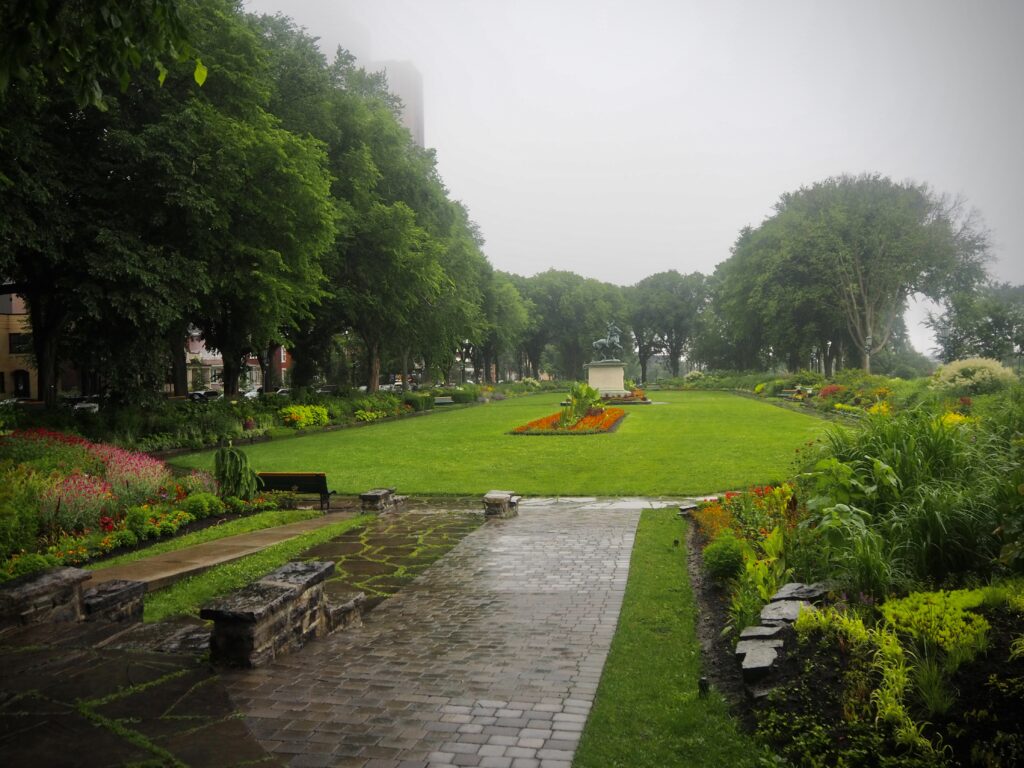


Parliament Building
Luckily the rain let up by the time we finished brunch and we resumed our sightseeing. Heading back towards the old town, we stopped to take a look at the Quebec Parliament Building, the administrative headquarters of the province. It’s a huge, impressive building, with statues of Quebec’s historic founders set into the facade. They offer guided tours most of the week, but is closed on Sunday, when we were there. The exterior is worth seeing anyways though!
Citadelle de Quebec
Then we continued on to the Citadelle de Quebec, the military fortress built to guard the city. We opted not to visit the inside, as military history isn’t really my cup of tea, but you can walk along the tops of its star-shaped walls for free. There are glimpses of its inner buildings from here, and we spied the changing of the guard, since it’s still an active fort. That certainly felt quite British, seeing their tall black bearskin hats and red uniforms, just like those at Buckingham Palace! The fortress walls led us back towards Dufferin Terrace, with more views of the Chateau Frontenac again. We had planned to take the funicular again, but it was closed for renovation, so we ended up taking the steep Frontenac Stairs instead.





Museum of Civilization
As the weather forecast had never been great today, our plan had always been for an indoor activity. Specifically, the Museum of Civilization had caught my interest. I wasn’t entirely sure what it would include, other than social histories, and was pleasantly surprised by the diversity of its exhibits. First we saw an exhibit on gender and sexuality, much of which I already knew but was happy to see being talked and taught about for sure! I also learned what Two-Spirit, and Indigenous identity, means so that was new!
Continuing on, we saw a large exhibit on the Indigenous history of the Quebec province, which is always an important inclusion. I’ve enjoyed learning about all the different tribes all across Canada these last weeks. Then we nearly got lost in the exhibit about the world’s environmental issues, which has lots of proposed ideas on what future societies might look like with potential solutions. It was nice to see something hopeful about our future in the midst of so much climate anxiety. There was also a whole exhibit wall of green objects – slightly random, but kind of fun!

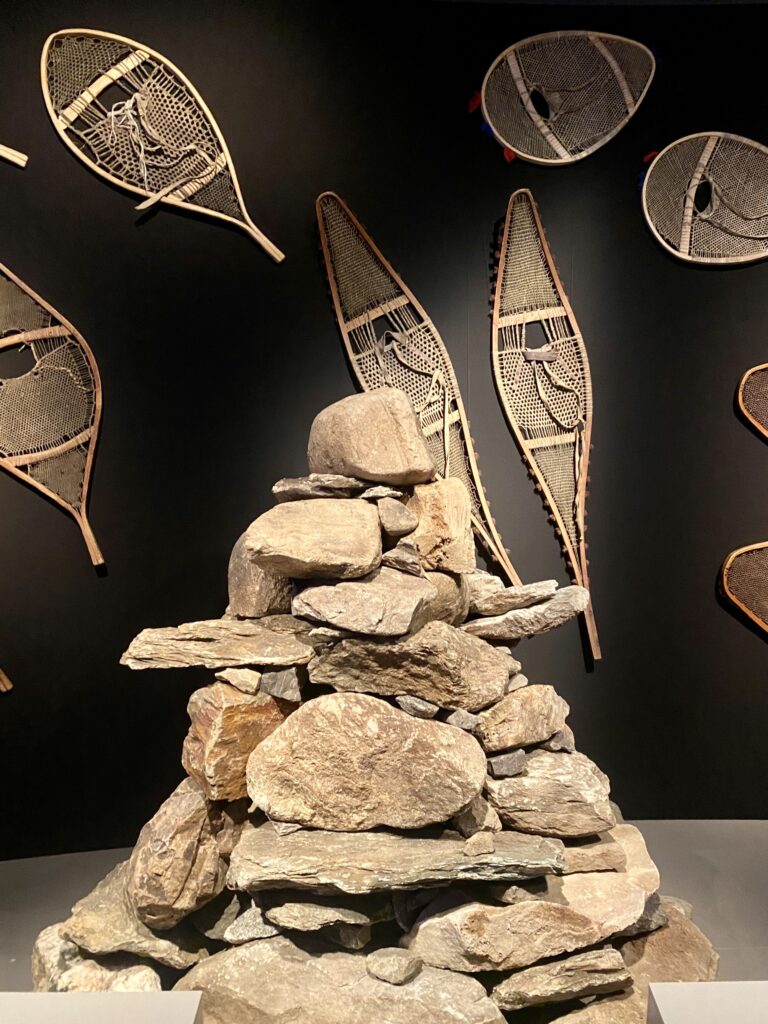



Place Royale
Leaving the museum, we wandered back around the corner to Place Royale. We’d passed through here yesterday and even stopped for a drink at one of the outdoor terraces in the sun (when I took these photos!). It’s a cobblestone square with a small church at one end and the buildings look almost rural and provincial here. A few of them have murals that link up to form a pattern across the buildings, which is a really cool effect! It was still pretty wet and grey today, but we browsed a few of the shops around here for souvenirs.
We returned to the same pub as yesterday, L’Oncle Antoine, but this time indoors to their cellar. They serve maple whisky here, a Quebec creation that Dad and I were eager to try and quite enjoyed! We whiled away an hour or so here before our dinner reservation nearby at Bistro L’Orygine. Like Sauavage back in Canmore, the female chef focuses on local, organic, sustainable ingredients. We chose their tasting menu, mine vegetarian again, for lots of delicious courses!
Basse-Ville
To return to our apartment for the night, we actually managed to skip the hill this time! Heading north from the restaurant, we made our way towards the Basse-Ville, where we walked alongside the Old Port. We couldn’t see all that much after dark but it was a new area of the city to wander through. We passed by many other restaurants in the area, and then past the train station where we were headed in the morning again to travel on to Ontario.





A Weekend in Quebec City
Our weekend in Quebec City was a lovely one, enjoying this very pedestrian-friendly city. We definitely walked around the same areas more than once, since it’s pretty small. But it was nice to have everything close together and not feel the need to rush. It also helped me that it was a weekend so I had two whole days there without working! A slower paced weekend was much needed after several busy weeks, though we still fit plenty in. I knew very little about Quebec City before this trip so it was a pleasant surprise with its European style and interesting history.

Highlights of Montreal | Canada
You May Also Like
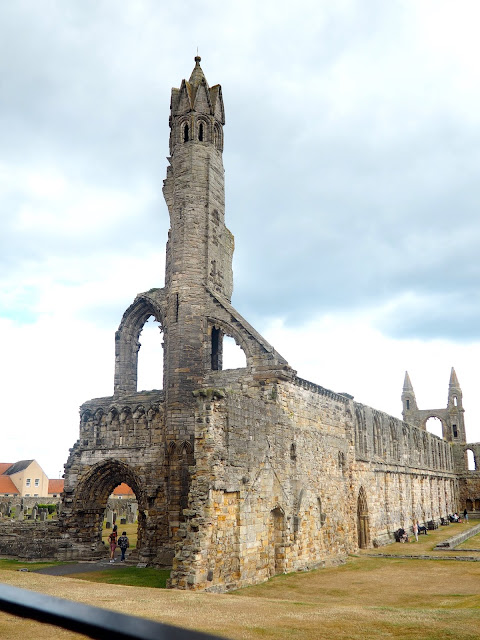
St Andrews Day Trip | Scotland
3 August 2018
A-Z of East & South East Asia
13 September 2018
